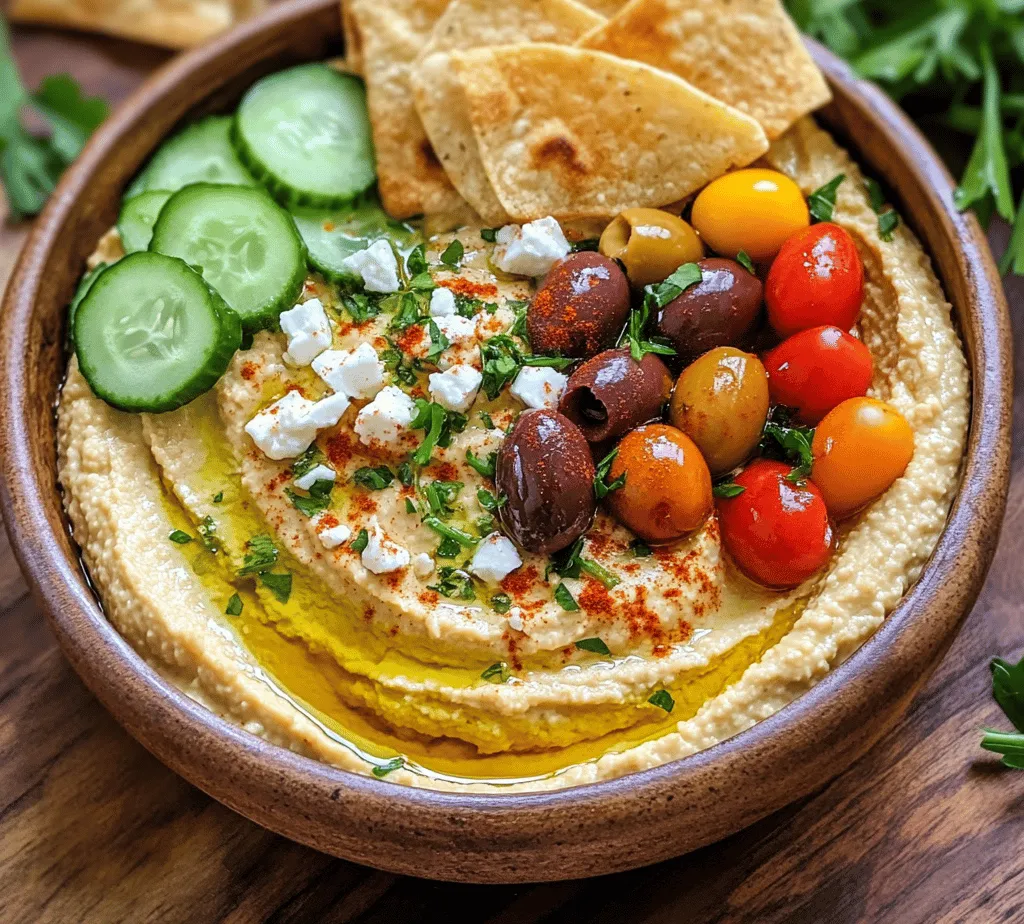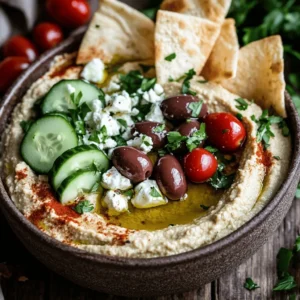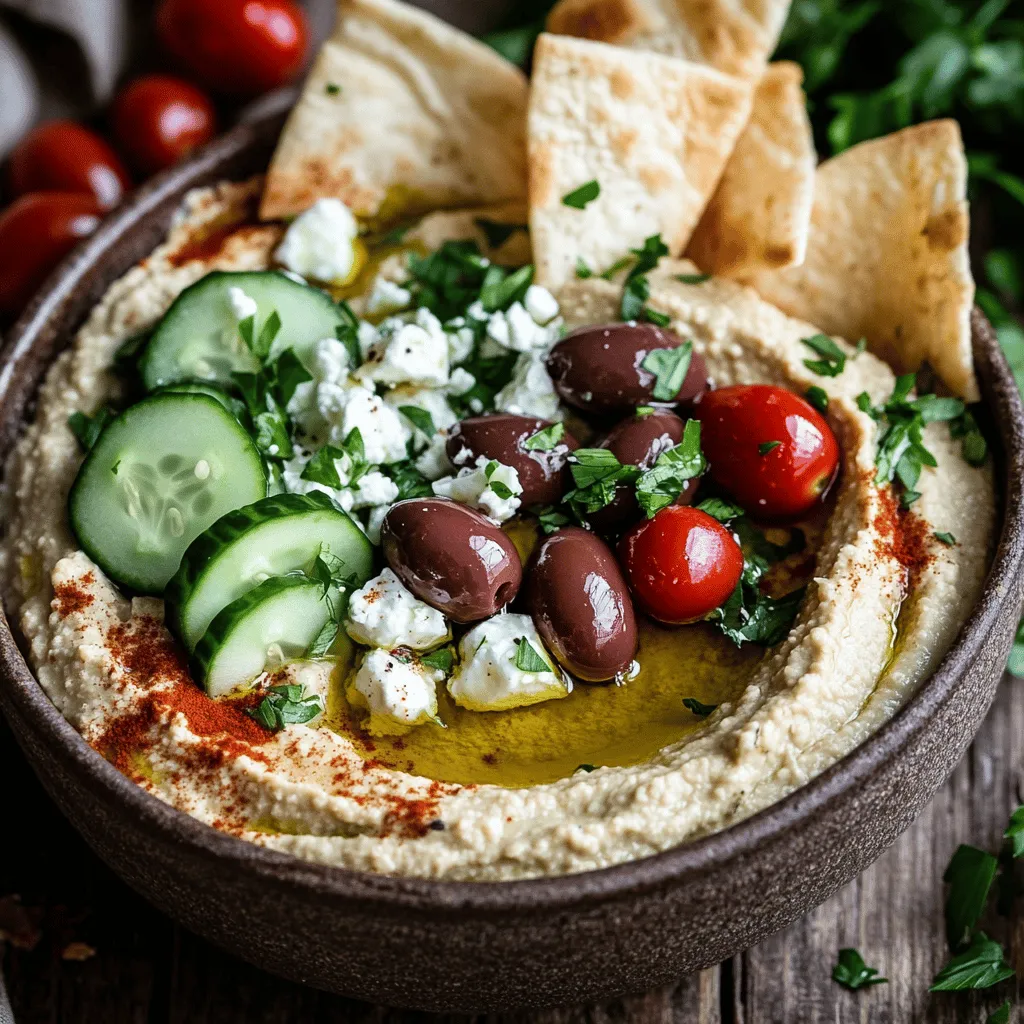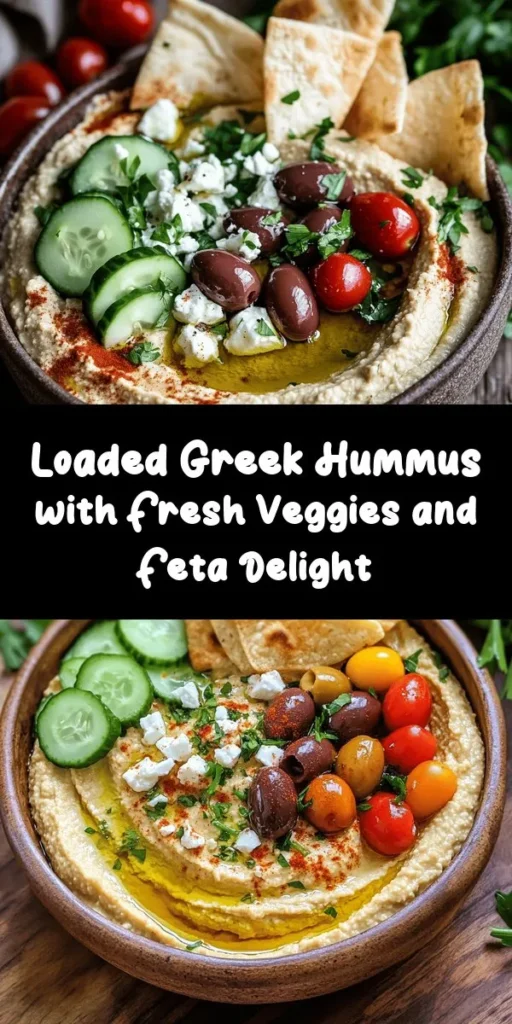Introduction
Hummus has rapidly gained popularity across the globe, celebrated not only for its creamy texture and rich flavor but also for its versatility as a healthy snack. Originating in the Middle East, hummus has become a staple in Mediterranean cuisine and is now a common feature in households and restaurants alike. Among the various interpretations of this beloved dish, Greek Style Loaded Hummus stands out, offering a delightful combination of traditional hummus with fresh, vibrant toppings that enhance its flavor and nutritional profile.
This Greek Style Loaded Hummus is a feast for the senses, blending the classic elements of hummus with an array of Mediterranean ingredients. Picture a smooth, velvety base of chickpeas and tahini, topped with colorful vegetables, crumbled feta cheese, and a drizzle of olive oil. Each bite bursts with flavor, making it a perfect appetizer for gatherings, a wholesome snack for the family, or a nutritious addition to your lunchbox. The beauty of this dish lies not just in its taste, but also in its ability to provide a healthy snacking option that aligns with a balanced diet.
In today’s health-conscious world, finding snacks that are both delicious and nutritious is paramount. Greek Style Loaded Hummus ticks all the boxes, offering a rich blend of flavors and textures that are sure to satisfy cravings without the guilt. Let’s delve into the rich history of hummus, its nutritional benefits, and the unique ingredients that make this recipe a must-try.
The Classic Appeal of Hummus
Hummus has a storied history that dates back thousands of years, with its origins rooted in Middle Eastern cuisine. The word “hummus” itself derives from the Arabic word for chickpeas, which are the main ingredient in this creamy dip. Its exact origins are fiercely debated, with claims from various countries in the region, including Lebanon, Israel, and Palestine, each boasting their own version of this beloved dish.
Hummus is not just a delicious treat; it is a nutritional powerhouse. Chickpeas, the star ingredient, are packed with protein, fiber, and essential vitamins and minerals. They are particularly high in folate, which is crucial for cell production and maintenance, and iron, which is vital for healthy blood. The addition of tahini, made from ground sesame seeds, not only enhances the creaminess of hummus but also contributes healthy fats, calcium, and antioxidants. This combination makes hummus an ideal choice for those seeking to add nourishing, plant-based foods to their diet.
The versatility of hummus is another factor contributing to its popularity. Whether served as a dip with pita bread, a spread on sandwiches, or a topping for salads, hummus adapts effortlessly to different culinary applications. The rise of plant-based diets has further propelled its appeal, as more people seek to incorporate healthy, vegetarian options into their meals. As we explore the Greek Style Loaded Hummus, we will see how this dish builds upon the classic appeal of traditional hummus while adding a unique twist that highlights Greek flavors.
Ingredient Breakdown
Understanding the ingredients that go into Greek Style Loaded Hummus is vital to appreciating its rich flavor and nutritional benefits. Each component plays a specific role, enhancing both the taste and health profile of the final dish.
Chickpeas
At the heart of hummus is chickpeas, also known as garbanzo beans. These legumes are not only the base of the dish but also a nutritional powerhouse. Rich in protein and fiber, chickpeas help promote satiety, making them an excellent choice for those looking to manage their weight. They are also a good source of vitamins and minerals, including vitamin B6, magnesium, and potassium. The smooth, creamy texture of blended chickpeas forms the perfect base for our loaded hummus, providing both body and flavor.
Tahini
Tahini is a key ingredient that elevates hummus to new heights. Made from ground sesame seeds, tahini adds a rich, nutty flavor and a creamy texture that is essential for achieving the classic hummus consistency. Beyond its flavor, tahini is packed with healthy fats, particularly monounsaturated fats, which are beneficial for heart health. Additionally, it contains calcium and other minerals that contribute to bone health. The nutty notes of tahini harmonize beautifully with the chickpeas, creating a smooth and indulgent base for our Greek Style Loaded Hummus.
Olive Oil
A staple of Mediterranean cuisine, olive oil is renowned for its health benefits and flavor-enhancing properties. Rich in monounsaturated fats and antioxidants, olive oil is linked to numerous health benefits, including reduced inflammation and improved heart health. In our loaded hummus, a generous drizzle of high-quality extra virgin olive oil not only adds a silky texture but also enriches the flavor profile, making each bite more satisfying.
Lemon Juice
Fresh lemon juice is essential for brightening the flavors of hummus. Its acidity helps balance the creaminess of tahini and chickpeas, ensuring that the dish does not become overly rich. Lemon juice is also a fantastic source of vitamin C, which supports the immune system and enhances iron absorption from plant-based foods. The zesty notes of lemon juice bring a refreshing lift to Greek Style Loaded Hummus, making it even more enjoyable.
Garlic
Garlic adds depth and aromatic qualities to the hummus, infusing it with a savory flavor that is hard to resist. Known for its numerous health benefits, garlic has been used for centuries as both a culinary ingredient and a medicinal herb. It boasts anti-inflammatory and antioxidant properties, making it a great addition to any dish. The pungent aroma of garlic complements the other ingredients in our hummus, creating a well-rounded flavor profile that is both delicious and nutritious.
Ground Cumin
Ground cumin introduces a warm, earthy flavor to our Greek Style Loaded Hummus. This spice is a staple in Middle Eastern and Mediterranean cooking, known for its distinctive aroma and taste. Cumin is also rich in iron and has been linked to digestive health benefits. Its warm notes enhance the overall flavor of the hummus, adding complexity and richness that elevates the dish.
Fresh Vegetables and Feta
One of the defining features of Greek Style Loaded Hummus is its toppings. Fresh vegetables such as diced cucumbers, tomatoes, and bell peppers not only provide a burst of color but also enhance the texture and nutritional value of the dish. These vegetables are low in calories but high in vitamins, minerals, and fiber, making them a perfect complement to the creamy hummus.
Feta cheese, another hallmark of Greek cuisine, adds a tangy and salty flavor that contrasts beautifully with the smooth hummus. Rich in calcium and protein, feta contributes to the overall nutritional profile of the dish while providing a flavor punch that is distinctly Mediterranean.
Smoked Paprika
For a unique flavor twist, smoked paprika is sprinkled on top of the hummus. This spice adds a subtle smokiness that elevates the dish, providing an unexpected depth of flavor. Smoked paprika is rich in antioxidants and can enhance the overall taste experience, making each bite more exciting.
Pita Chips
Finally, no hummus is complete without a crunchy accompaniment. Pita chips are the perfect vessel for scooping up our Greek Style Loaded Hummus. Made from baked pita bread, they offer a satisfying crunch that contrasts with the creamy texture of the hummus. You can make your own or purchase them pre-made for convenience. Either way, they are an essential part of the hummus experience, ensuring that each bite is flavorful and enjoyable.
Step-by-Step Instructions for Greek Style Loaded Hummus
Now that we’ve explored the rich history and vibrant ingredients that make up Greek Style Loaded Hummus, it’s time to dive into the preparation. This section will guide you through the simple steps to create this delicious dish from scratch.
1. Prepare the Chickpeas: If using dried chickpeas, soak them overnight in water. Drain and rinse before cooking until tender. If using canned chickpeas, drain and rinse them thoroughly to remove excess sodium and preservatives.
2. Blend the Base: In a food processor, combine the cooked chickpeas and tahini. Pulse until the mixture is smooth and creamy. If the texture is too thick, add a tablespoon of cold water at a time until the desired consistency is reached.
3. Add Flavor Components: Next, add the olive oil, lemon juice, minced garlic, ground cumin, and a pinch of salt. Blend again until fully incorporated, tasting and adjusting the seasoning as necessary.
4. Serve and Load: Transfer the hummus to a serving bowl, smoothing the top with a spatula. Drizzle a little extra olive oil over the surface and sprinkle with smoked paprika for an added flavor boost.
5. Top with Fresh Ingredients: Arrange the diced vegetables and crumbled feta cheese on top of the hummus. Feel free to get creative with the toppings, adding your favorite Mediterranean ingredients.
6. Garnish and Enjoy: Finally, serve the Greek Style Loaded Hummus with pita chips for dipping. Enjoy with friends and family, or store in the refrigerator for later use.
As we continue with this article, we will explore more tips for achieving the perfect Greek Style Loaded Hummus, along with answers to common questions about this delightful dish. Stay tuned to unlock the secrets to making this vibrant snack a staple in your kitchen.

Detailed Guide to Making Hummus from Scratch
Creating Greek Style Loaded Hummus begins with the right preparation of your chickpeas, which form the base of this creamy dip. To start, you can either use dried chickpeas or canned ones. If you opt for dried chickpeas, soak them overnight in plenty of water. This step is crucial as it helps to soften the beans, making them easier to blend and digest. The next day, drain and rinse the chickpeas, then boil them in fresh water for about an hour or until they are tender. If you’re short on time, canned chickpeas can be a convenient alternative; just be sure to rinse them thoroughly to remove excess sodium.
Once your chickpeas are ready, it’s time to blend the base. In a food processor, combine the cooked chickpeas, tahini (a sesame seed paste that gives hummus its signature flavor), fresh lemon juice, garlic, and a pinch of salt. Blend these ingredients until they form a smooth paste. If the mixture is too thick, add a tablespoon of water at a time until you reach your desired consistency. For a touch of extra flavor, you can drizzle in some olive oil while blending, which will also enhance the creaminess of your hummus.
Creating the Vegetable Topping
While your hummus base is blending, you can prepare the vegetable topping that will elevate your dish. For a Greek-inspired version, consider using a medley of fresh, colorful vegetables. Diced cucumbers, cherry tomatoes, red onions, and bell peppers work wonderfully together. You can also add olives or artichoke hearts for an authentic Mediterranean touch.
To create the topping, finely chop your selected vegetables and mix them in a bowl. Season the mixture with a splash of olive oil, a squeeze of lemon juice, and a sprinkle of salt and pepper. This mixture will add texture and a burst of flavor to your hummus. Additionally, for a herbaceous touch, consider adding fresh chopped parsley or dill, which complements the other ingredients beautifully.
Assembling the Dish for Presentation
Once your hummus and vegetable topping are ready, it’s time to assemble the dish for a stunning presentation. Use a wide, shallow bowl for serving; this not only looks appealing but also makes it easy for guests to dip. Spoon the hummus into the center of the bowl, using the back of a spoon to create a small well in the center. This well is perfect for drizzling a bit more olive oil and placing your vegetable mixture.
Arrange the chopped vegetables evenly around the hummus, allowing the vibrant colors to contrast beautifully with the creamy dip. To finish, garnish with a sprinkle of smoked paprika or sumac for a touch of color and flavor. You can also add a few whole chickpeas on top for added texture. This visually appealing dish is not only a feast for the eyes but also a delicious treat for the palate.
Tips for Achieving the Perfect Consistency and Flavor Balance
Achieving the perfect consistency and flavor balance in your Greek Style Loaded Hummus is key to creating an unforgettable dish. Here are some useful tips:
1. Consistent Blending: Ensure that your food processor is powerful enough to blend the chickpeas into a smooth paste. If necessary, scrape down the sides of the bowl to ensure all ingredients are well incorporated.
2. Water and Olive Oil: Control the thickness of your hummus by gradually adding water or olive oil. Start with a tablespoon and blend, then add more as needed until you reach your desired creaminess.
3. Taste as You Go: Always taste your hummus as you blend and adjust the seasoning accordingly. A little more lemon juice can brighten the flavors, while additional salt can enhance overall taste.
4. Chill Before Serving: For the best flavor, allow your hummus to chill in the refrigerator for at least 30 minutes before serving. This resting period allows the flavors to meld beautifully.
5. Fresh Ingredients: Use fresh, high-quality ingredients, particularly for the vegetables and herbs. Freshness dramatically impacts flavor, particularly in simple dishes like hummus.
Serving Suggestions and Pairings
Greek Style Loaded Hummus makes for a delightful appetizer or a healthy snack option. Here are some serving suggestions to make your meal memorable:
– Mediterranean Platter: Serve the hummus alongside pita bread, falafel, and an assortment of fresh vegetables like carrot sticks, bell pepper strips, and cucumber slices for a colorful and nutritious platter that is perfect for sharing.
– Garnish with Feta: Crumbled feta cheese can be sprinkled on top of the hummus for an added layer of flavor and a touch of creaminess that complements the chickpeas.
– Accompanying Salads: Pair your hummus with a refreshing Greek salad or tabbouleh for a light lunch. The crisp veggies and bright flavors will harmonize beautifully with the richness of the hummus.
– Grilled Meats: For a heartier meal, serve your hummus alongside grilled chicken, lamb, or shrimp. The savory flavors of the grilled meats contrast nicely with the creamy dip.
– Wine Pairings: A crisp white wine, such as Sauvignon Blanc or a light red like Pinot Noir, pairs well with the flavors of hummus. Consider serving it with a chilled beverage for a refreshing experience.
Variations to Consider for Different Dietary Needs
One of the best aspects of hummus is its versatility. Here are some variations to accommodate different dietary preferences:
– Vegan: Hummus is naturally vegan, but ensure that any additional toppings or garnishes are compliant with vegan diets.
– Gluten-Free: Served with gluten-free dippers such as rice crackers or fresh vegetable sticks, hummus is a great snack for gluten-sensitive individuals.
– Low-Carb: For those following a low-carb diet, using sliced cucumbers or bell peppers as dippers instead of pita bread can provide a satisfying crunch without the carbs.
– Spicy Options: If you enjoy heat, consider adding a pinch of cayenne pepper or a drizzle of harissa for a spicy twist. You can also blend roasted red peppers into the hummus for added flavor and color.
Nutritional Analysis
Understanding the nutritional content of your Greek Style Loaded Hummus is essential for maintaining a balanced diet. Here’s a breakdown of what you can expect per serving (approximately 1/4 cup):
– Calories: ~150
– Protein: 5g
– Carbohydrates: 15g
– Fat: 8g
– Fiber: 4g
Health Benefits Associated with the Ingredients
– Chickpeas: A fantastic source of plant-based protein and dietary fiber, chickpeas help regulate blood sugar and promote digestive health.
– Tahini: Rich in healthy fats and vitamins, tahini provides essential fatty acids beneficial for heart health.
– Olive Oil: A staple in Mediterranean diets, olive oil is loaded with antioxidants and has anti-inflammatory properties.
– Vegetables: The fresh veggies not only add flavor and texture but also contribute essential vitamins and minerals vital for overall health.
Discussion on Portion Control and Moderation
While hummus is a nutritious snack, moderation is key. Due to its calorie density, it’s important to be mindful of portion sizes, especially if you are pairing it with high-calorie dippers. Pairing hummus with a variety of fresh vegetables can help you fill up without consuming too many calories.
The Cultural Significance of Hummus in Greek Cuisine
Hummus is more than just a popular dip; it holds cultural significance in Greek and broader Mediterranean cuisine. Traditionally, it is served as part of meze, a collection of small dishes meant for sharing, which fosters community and connection during meals. In Greece, fresh ingredients are a cornerstone of daily meals, and hummus exemplifies this philosophy by using simple yet flavorful components.
The Mediterranean diet emphasizes whole, unprocessed foods, which are not only delicious but also promote long-term health. Incorporating dishes like Greek Style Loaded Hummus into your diet can contribute to a balanced lifestyle, rich in flavors and nutrients.
Conclusion
Greek Style Loaded Hummus is a delightful and healthy addition to any meal or gathering. With its creamy texture, vibrant vegetable toppings, and rich flavors, it’s sure to please a crowd while providing a nutritious snack option. Making this dish at home is not only rewarding but also allows you to control the ingredients, ensuring the best quality.
By experimenting with variations and serving suggestions, you can customize this dish to suit your tastes and dietary needs. Embrace the joy of cooking and the importance of incorporating flavorful, nutritious foods into your daily life, and enjoy the journey of creating this Mediterranean classic in your own kitchen.



